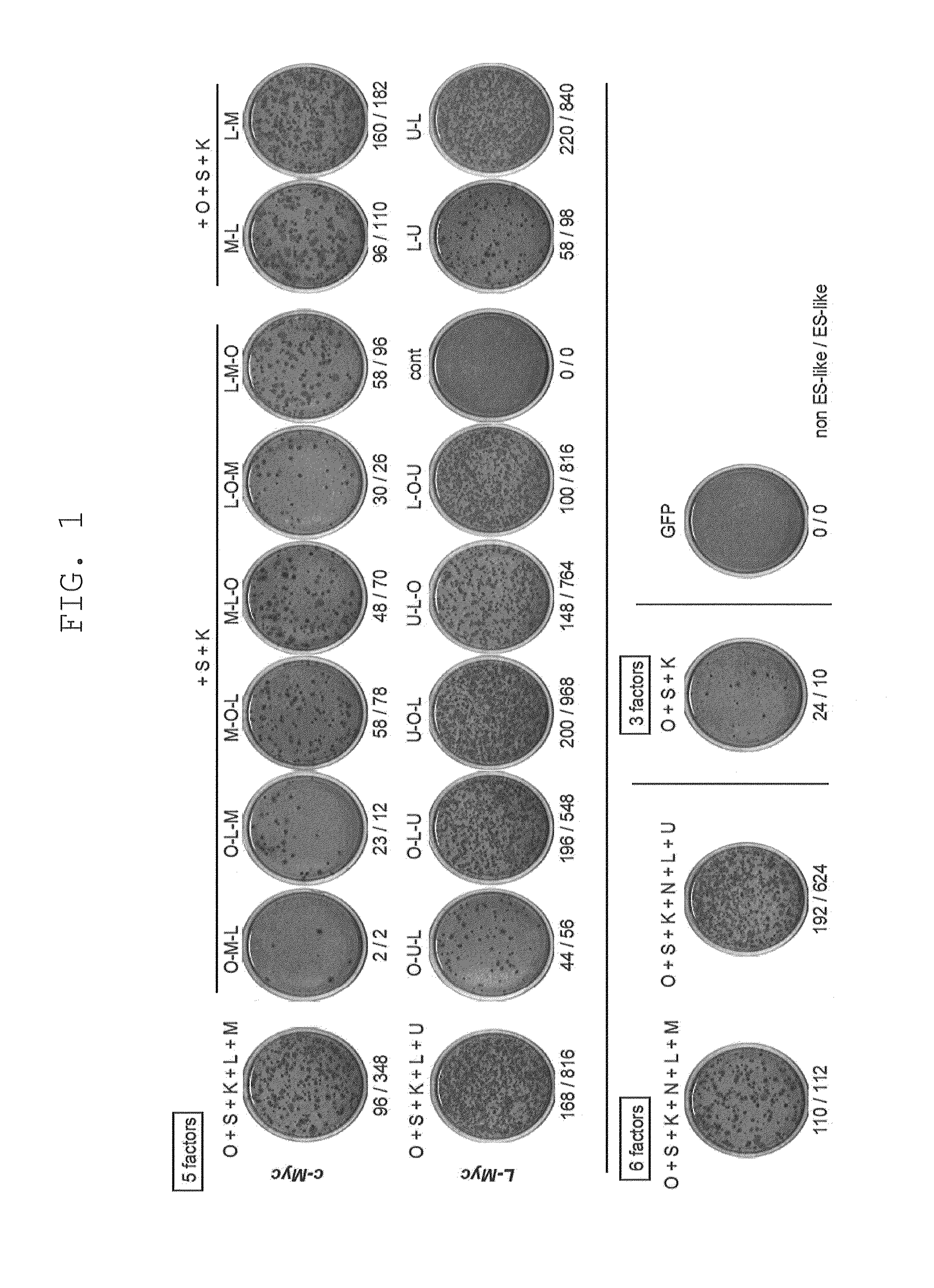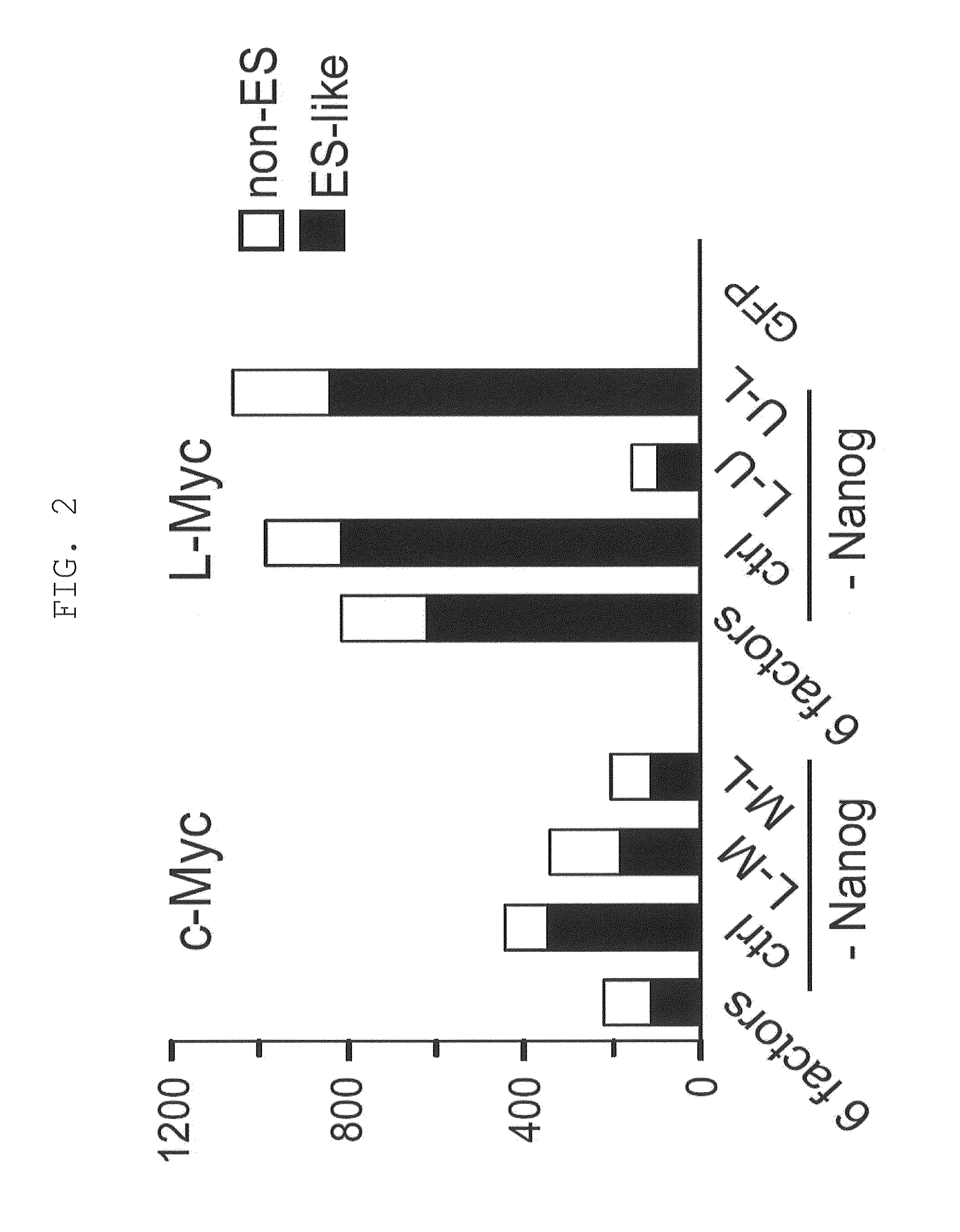Method of efficiently establishing induced pluripotent stem cells
a technology of efficient establishment, which is applied in the field of efficiently establishing induced pluripotent stem cells, can solve the problems of low ips cell establishment efficiency at less than 1%, low ips cell establishment efficiency, tumorigenesis in tissues or individuals, etc., and achieves the effect of efficiently producing an ips cell, improving the establishment efficiency of ips cells, and efficient establishing human ips cells
- Summary
- Abstract
- Description
- Claims
- Application Information
AI Technical Summary
Benefits of technology
Problems solved by technology
Method used
Image
Examples
example 1
Establishment of Human iPS Cells Using Retroviruses
[0220]Retroviruses for reprogramming were prepared on the basis m of the pMXs plasmid and Plat-E packaging cells [supplied by Dr. Toshio Kitamura at the University of Tokyo; Morita, S. et al., Gene Ther. 7, 1063-1066 (2000)]. Various constructs were inserted into the multicloning site of pMXs to yield retroviral vectors to be used for reprogramming. The constructs inserted were prepared by joining human Oct3 / 4 (O in FIG. 1), human Sox2 (S in FIG. 1), human Klf4 (K in FIG. 1), human c-Myc (M in FIG. 1), human Lin28 (L in FIG. 1), human Nanog (N in FIG. 1), and human L-Myc (U in FIG. 1), and the translated region of each gene via the 2A sequence of foot- and-mouth disease virus [in FIG. 1, symbols for respective genes (shown above) are hyphenated (e.g., O-M-L)]. GFP was used as a negative control.
[0221]Each retrovirus for reprogramming was prepared by transferring each of the aforementioned retroviral vectors to Plat-E cells that had ...
example 2
Establishment of Human iPS Cells Using Episomal Plasmids (1)
[0224]A plasmid for reprogramming was prepared on the basis of pCX-EGFP (supplied by Dr. Masaru Okabe at Osaka University; FEBS Letters, 407, 313-319, 1997). First, the woodchuck hepatitis virus posttranscriptional regulatory element (WPRE) sequence was inserted downstream of EGFP. A cassette for replicating this vector in the cell was prepared by inserting a loxP sequence into both ends of the EBNA-1 of pCEP4 (Invitrogen). This cassette containing the EBNA-1 and oriP was integrated into the BamHI site of the aforementioned pCX-EGFP incorporating the WPRE, and this was named pCXLE-EGFP. This pCXLE-EGFP was treated with EcoRI, and various constructs, in place of EGFP, were inserted to yield plasmids for reprogramming. The five constructs inserted were: 1) human Oct3 / 4, 2) a construct prepared by joining the translated regions of human Sox2 and human Klf4 via the 2A sequence of foot-and-mouth disease virus, 3) a construct pre...
example 3
Establishment of Human iPS Cells Using Episomal Plasmids (2)
[0226]Four different plasmids, other than pCX-SV40LT, which was used in Example 2, were used for reprogramming: pCXLE-hOct4, pCXLE-hSK, pCXLE-hKSO, and pCXLE-hMLN.
[0227]In the experiments, a fibroblast established from a facial skin from a 36-year-old Caucasian female (Cell Applications, Lot1388) was used. This fibroblast was cultured and maintained at 37° C. in the presence of 5% CO2 in a 100 mm culture dish using DMEM / 10% FCS [a culture broth prepared by adding 10% fetal bovine serum to DMEM (Nacalai Tesque)]. At the time of plasmid transfer, the medium was removed, and the cells were washed by the addition of 5 mL of PBS. After removing the PBS, 0.25% Trypsin / 1 mM EDTA (Invitrogen) was added, and a reaction was carried out at 37° C. for about 5 minutes. After the cells rose, DMEM / 10% FCS was added to suspend the cells, and 6×105 cells were recovered in a 15 mL centrifugal tube. The suspension was centrifuged at 800 rpm f...
PUM
| Property | Measurement | Unit |
|---|---|---|
| temperature | aaaaa | aaaaa |
| diameter | aaaaa | aaaaa |
| time | aaaaa | aaaaa |
Abstract
Description
Claims
Application Information
 Login to View More
Login to View More - R&D
- Intellectual Property
- Life Sciences
- Materials
- Tech Scout
- Unparalleled Data Quality
- Higher Quality Content
- 60% Fewer Hallucinations
Browse by: Latest US Patents, China's latest patents, Technical Efficacy Thesaurus, Application Domain, Technology Topic, Popular Technical Reports.
© 2025 PatSnap. All rights reserved.Legal|Privacy policy|Modern Slavery Act Transparency Statement|Sitemap|About US| Contact US: help@patsnap.com



